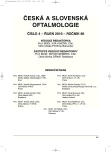-
Medical journals
- Career
The Diagnostics of Tapetoretinal Dystrophies Using Electrophysiological Methods
Authors: T. Štětinová; A. Gerinec
Authors‘ workplace: Klinika detskej oftalmológie DFNsP-LFUK, Bratislava, Slovakia, prednosta prof. MUDr. A. Gerinec, CSc.
Published in: Čes. a slov. Oftal., 66, 2010, No. 4, p. 159-164
Category: Original Article
Overview
Purpose:
The purpose of our study was to determine the diagnostic criteria of hereditary tapetoretinal dystrophies. In time of ten years we have followed the course of the disease, the manifestation and the change of the electrophysiological parameters in investigated patients.Material and methods:
At Dept. of Paediatric Ophthalmology in Bratislava we have examined 758 subjects (from 144 families) with suspicion of retinal disease. The subjects of control group were 60, they were divided to the special groups by the age. This step was necessary to make our internal standards of the electrophysiologic machine LACE 2000 16-C.We have to follow the international standards of the ISCEV/ISCERG organisation.
Results:
On the basis of electrophysiology retinal dystrophies have been proved in 495 patients. Internal standards were very helpful for us, so we were able to suggest, which kind of acquired parameters were physiological and which were pathological. We could concreted the type of the diagnosis of each of them and, if it was possible, to recommend the treatment. The most frequent diagnosis was retinal pigment dystrophy (166/495), then f. flavimaculatus (76/495)// m. Stargardt (57/495), then m. Best (36/495) and the dystrophy of the cones (23/495) in our patients. Very important is to estimate ERG findings in correlation with other clinical investigation.Conclusion:
Electrophysiological testing is the basic ophthalmologic investigation, it’s very helpful by the assessing of the correct and objective diagnosis. Very important is to correlate the acquired electrophysiological parameters with other ophthalmological diagnostic procedureKey words:
tapetoretinal dystrophies, electrophysiological methods, ERG, EOG, VEP, genealogy
Sources
1. Alexandridis E., Krastel H.: Elektrodiagnostik in der Ophtalmologie. Springer – Verlag, Berlin, 1991, 6–31.
2. Ciancia, A. O.: On infantile esotropia with nystagmus in abduction. J. Pediatric Ophthalmol. Strab., s. 280–287.
3. Cigánek, L.: Evokované potenciály a ich využitie v klinickej praxi. Osveta, Martin, 1991, 95 s.
4. Chiappa, G.: Evoked Potentials, Philadelphia, RavenPress, 1987, 261 s.
5. Cobb, W.A., Morton, H.B.: A new component of the human electroretinogram. J. Physiol., 1954, 123, 36–38.
6. Elschnig, H.: Glaukom. Handbuch der spez. pathol. Anatomie und Histologie, Springer-Verlag, Berlin, 1928, 917 s.
7. Fishmann, G. A., Sokol, S.: Electrophysiologic Testing in Disorders of the Retina, Optic Nerve and Visual Pathways. Arch of Ophthal, 1991, 109, 92–101.
8. Fulton, A. B., Hartmann, E. E., Hansen, R. M.: Electrophysiologic testing techniques for children. Docum. Ophthalmol., 1989, 71, 341–354.
9. Gerinec, A.: Detská oftalmológia, Osveta, Martin, 2005, 593 s.
10. Gouras, P.: Electroretinography: some basic principles. Invest Ophthalmol., 1970, 9, s. 557–569.
11. Heckenlively, J.R., Arden, G.B.: Principles and Practice of Clinical Electrophysiology of Vision. St. Louis, Second edition, The Mit Press, Massachussetts, 2006, 1200 s.
12. Hrachovina, V., Riebel, O.: Prognostický význam ERG u odchlípení sítnice. Čs. Oftal., 1974, 30, 185–189.
13. Marmor, M.F., Zrenner, E.: Standard for clinical electro-oculography (2006 update), Arch. Ophthalmol., 1993, 111, 601–604.
14. Marmor, M.F., Zrenner, E.: Standard for clinical electroretinography (2008 update). Doc. Ophthalmol., 1998, 97, 143–156.
15. Marmor, M.F., Holder, G.E., Seeliger, M.W., Yamamoto, S.: Standard for clinical electroretinography (2007 update). Doc. Ophthalmol., 2004, 108, 107–114.
16. Peregrín, J., Svěrák, J., Kremláček, J.: Oscilační potenciály u lidského elektroretinogramu v průběhu adaptace na světlo a tmu. Čes. a Slov Oftalmol., 1998, 54 (1), 3–9.
17. Peregrín J., Svěrák J., Kremláček J.: Oscilační potenciály lidského elektroretinogramu v adaptaci na tmu a světlo. Čs. Oftal., 1998, 3–7.
18. Shervin, J. I. a kol.: The eye in infancy, Boca Raton, Chicago, 1989, 522 s.
19. Spehlmann, R.: Evoked Potential Primer, Boston, Butterworth 1987, 389 s.
20. Svěrák, J., Rencová, E., Kvasnička, J.: Elektroretinografia u diabetes mellitus, Lék. zprávy LF UK Hradec Králové, 2000, 45, 179–186.
21. Svěrák, J., Kvasnička, J., Peregrín, J.: Skotopický elektroretinogram a věk. Čes. a Slov. Oftalmol. 2001, 57(1), 3–8.
22. Svěrák, J., Peregrín, J.: Elektrické sítnicové funkce u glaukomu. Čs Oftal., 1975, 31, 316–320.
23. Svěrák, J., Jebavá, R., Peregrín, J., Zizka, J., Hartmann, M.: Kongenitální stacionárni noční slepota. Čes. a Slov. Oftalmol., 1996, 52 (3), 135–142.
24. Šóth, J., Schingler, F.: Nový spôsob stimulovania zrakových evokovaných potenciálov. Čs. Oftal., 1995, 2, s. 111–113.
25. Traboulsi, E.I.: Genetic Diseases of the Eye, New York, Oxford University Press, 1998, 900 s.
26. Wright, K.W. et al.: Paediatric ophthalmology and strabismus, St. Louis, Mosby, 1995, 920 s.
Labels
Ophthalmology
Article was published inCzech and Slovak Ophthalmology

2010 Issue 4-
All articles in this issue
- Basalioma of the Eyelid: Rate and Factors of Recurrence after Surgical Therapy
- General Health State of Premature Children Treated for Retinopathy of Prematurity from 2007 to 2009
- The Embedded Mobile Orbital Implant from Methylmethacrylate „Hydron“ – Clinical and Histopathological Findings 25 Years after Implantation
- Non Arteriitic Anterior Ischemic Optic Neuropathy in Optic Nerve Drusen – A Case Report
- The Diagnostics of Tapetoretinal Dystrophies Using Electrophysiological Methods
- Purtscher-like Retinopathy in Acute Alcoholic Pancreatitis: Fluorescein Angiography and Optical Coherence Tomography Findings
- Czech and Slovak Ophthalmology
- Journal archive
- Current issue
- Online only
- About the journal
Most read in this issue- Non Arteriitic Anterior Ischemic Optic Neuropathy in Optic Nerve Drusen – A Case Report
- The Diagnostics of Tapetoretinal Dystrophies Using Electrophysiological Methods
- Basalioma of the Eyelid: Rate and Factors of Recurrence after Surgical Therapy
- The Embedded Mobile Orbital Implant from Methylmethacrylate „Hydron“ – Clinical and Histopathological Findings 25 Years after Implantation
Login#ADS_BOTTOM_SCRIPTS#Forgotten passwordEnter the email address that you registered with. We will send you instructions on how to set a new password.
- Career

